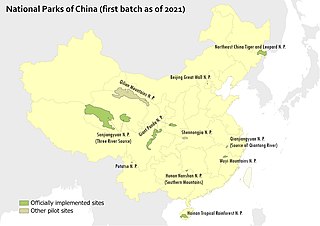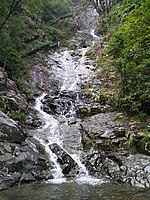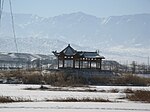
The People's Republic of China has 5 national parks, which are announced by the President of China and administered by the National Forestry and Grassland Administration.[1] The first designation list of national parks was released on October 12, 2021.
List of National Parks
[edit]The list is arranged in the order of official documents of the National Forestry and Grassland Administration.[1]
| Name | Image | Location | Official designation | Area (km2) | Description |
|---|---|---|---|---|---|
| Sanjiangyuan National Park
(三江源国家公园) |

|
Qinghai | October 12, 2021 | 123,100 | To protect source waters of three great rivers: Yangtze River, Lancang River and Yellow River.[2][3] |
| Giant Panda National Park
(大熊猫国家公园) |

|
Sichuan, Shaanxi, and Gansu | October 12, 2021 | 27,000[3] | To protect natural environmental corridors connecting different habitats of pandas.[3] |
| Northeastern Tiger and Leopard National Park
(东北虎豹国家公园) |

|
Jilin and Heilongjiang | October 12, 2021 | 14,600[3] | To recover communities and populations of wild tigers and leopards in northeastern China.[3] |
| Hainan Tropical Rainforest National Park
(海南热带雨林国家公园) |

|
Hainan | October 12, 2021 | 4,400[4] | To protect the tropical rainforest in Hainan.[4] |
| Wuyi Mountains National Park
(武夷山国家公园) |

|
Fujian | October 12, 2021 | 982.59[3] | To protect the biodiversity of the Wuyi Mountains.[3] |
List of trial sites
[edit]The trial sites are administered by the provincial governments with the approval of the central government. The trial sites are not part of the national park system of China, nor operated by the National Forestry and Grassland Administration.
| Name | Image | Location | Trial date | Area (km2) | Description |
|---|---|---|---|---|---|
| Hubei Shennongjia National Park
(湖北神农架国家公园) |

|
Hubei | May 14, 2016[5] | 1,170[3] | To protect local ecological systems of sub-tropical forests and sphagnum palustre swamplands.[3] |
| Zhejiang Qianjiangyuan National Park
(浙江钱江源国家公园) |

|
Zhejiang | July 15, 2016[6] | 252[3] | To protect endangered species near the source of Qiantang River.[3] |
| Hunan Nanshan National Park
(湖南南山国家公园) |

|
Hunan | August 8, 2016[7] | 635.94[3] | To protect birds and other ecological landscapes.[8] |
| Yunnan Potatson National Park
(普达措国家公园) |

|
Yunnan | October 26, 2016[9] | 602.1[3] | To protect local wetlands and grasslands.[8] |
| Beijing Great Wall National Park
(北京长城国家公园) |

|
Beijing | January 14, 2017[10] | 59.91[3] | To protect historical sites at Badaling Great Wall and Ming Tombs.[3] |
| Qilian Mountains National Park
(祁连山国家公园) |

|
Gansu and Qinghai | June 26, 2017[11] | 50,000[3] | To protect endangered species in the Qilian Mountains.[3] |
See also
[edit]Wikimedia Commons has media related to National parks of China.
References
[edit]- ^ a b "今天,第一批国家公园名单公布!_国家林业和草原局政府网". www.forestry.gov.cn. Retrieved 2024-03-05.
- ^ 青海省人民政府. "三江源国家公园条例(试行)". 青海省人民政府门户网站 (in Chinese (China)). 西宁. Archived from the original on 2017-09-30. Retrieved 2017-09-30.
- ^ a b c d e f g h i j k l m n o p q 李慧. "十个国家公园体制试点". 光明网 (in Chinese (China)). 北京. Archived from the original on 2017-09-30. Retrieved 2017-09-30.
- ^ a b "海南热带雨林国家公园规划" (PDF). 国家林业和草原局 (in Chinese (China)). Retrieved 2022-04-25.
- ^ 马超. "神农架国家公园体制试点正式实施". 神农架林区人民政府门户网站 (in Chinese (China)). 神农架. Archived from the original on 2017-09-30. Retrieved 2017-09-30.
- ^ 姚似璐. "钱江源国家公园试点获批,地处浙皖赣交界、为唯一跨省域试点". 澎湃新闻 (in Chinese (China)). 上海. Archived from the original on 2017-09-30. Retrieved 2017-09-30.
- ^ 蒋剑平; 戴勤. ""湖南南山国家公园"获国务院批复通过". 湖南在线 (in Chinese (China)). 长沙. Archived from the original on 2017-09-30. Retrieved 2017-09-30.
- ^ a b 高敬; 安蓓. "新闻链接:中国十大国家公园体制试点都在哪儿?". 新华网 (in Chinese (China)). 北京. Archived from the original on 2017-09-30. Retrieved 2017-09-30.
- ^ 澎湃新闻编辑. "高层发话云南普达措国家公园方案过关,曾因开发过度久拖不决". 网易网新闻 (in Chinese (China)). 广州. Archived from the original on 2017-09-30. Retrieved 2017-09-30.
- ^ 人民网编辑. "北京长城国家公园体制试点区实施方案获得批复". 人民网北京 (in Chinese (China)). 北京. Archived from the original on 2017-09-30. Retrieved 2017-09-30.
- ^ 中科院兰州分院. "《祁连山国家公园体制试点方案》获批". 中国科学院兰州分院 (in Chinese (China)). 兰州. Archived from the original on 2017-09-30. Retrieved 2017-09-30.